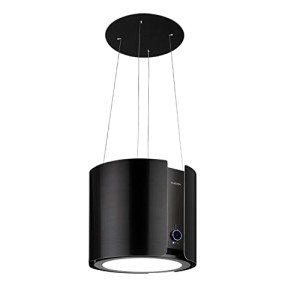The Comprehensive Guide to Island Cooker Hoods
In contemporary kitchens, the visual and functional aspects of home appliances are vital. One device that has actually acquired considerable appeal in open-plan kitchens is the black island Extractor fan cooker hood. These ventilation systems not only boost the kitchen’s visual appeal however likewise make sure that the air remains tidy and fresh while cooking. This article supplies an in-depth appearance at island slim Island range hood cooker hoods, including their functions, benefits, installation factors to consider, and maintenance ideas.
What is an Island Cooker Hood?
An island cooker hood is a ventilation system particularly created for kitchen islands. Unlike conventional hoods that install versus a wall, island hoods kitchen cooker hoods hang from the ceiling, directly above the cooking surface area. Their main function is to record smoke, steam, grease, and smells developed during cooking, enhancing air quality and making sure a pleasant cooking experience.
Features of Island Cooker Hoods
island hoods kitchen cooker hoods feature a variety of features that deal with various cooking styles and choices. Here are some crucial features to consider:
| Feature | Description |
|---|---|
| Style Variations | Offered in different designs and surfaces (e.g., stainless-steel, glass) to match kitchen decoration. |
| Ventilation Type | Can be ducted (venting air exterior) or ductless (filtering and recirculating air). |
| Sound Levels | Different designs discharge varying noise levels; some are developed for quieter operation. |
| Lighting | Integrated lights help light up the cooking location, enhancing exposure while preparing food. |
| Control Options | Models use manual or electronic controls, consisting of push-button controls and touchscreens. |
| Filters | Usually geared up with grease and charcoal filters to trap grease and smells efficiently. |
Advantages of Installing an Island Cooker Hood
Picking to install an island hob cooker hood comes with multiple benefits:
- Enhanced Air Quality: By effectively getting rid of smoke, steam, and odors, these hoods promote a healthier cooking environment.
- Visual Appeal: The streamlined style of island hoods adds a touch of sophistication and modernity to the kitchen.
- Space-Saving: Unlike bulky wall hoods, island hoods supply ventilation without taking up important wall area.
- Adjustable Options: With numerous designs, sizes, and performances readily available, property owners can find a cooker hood that fits their particular requirements.
- Enhanced Cooking Experience: With efficient ventilation, cooking ends up being more enjoyable and efficient.
Installation Considerations
Setting up an island cooker hood needs mindful preparation and consideration. Here are important aspects to bear in mind:
- Ceiling Height: The range from the cooktop to the hood should ideally be between 30 to 36 inches for optimal air capture and security.
- Ducting Requirements: If you go with a ducted hood, guarantee that the ceiling can accommodate the necessary ductwork for venting.
- Electrical Wiring: Proper electrical installations need to be made to power the hood, particularly if it has advanced features like lighting and fans.
- Weight Support: Consider the structural integrity of the ceiling, as island hoods can be heavy and require adequate assistance for [empty] safe setup.
- Regional Building Codes: Always examine local regulations and building codes to ensure compliance.
Setup Steps
- Step the Space: Determine the perfect location based upon your cooktop and ceiling height.
- Check Structural Support: Ensure ceiling joists can support the hood’s weight.
- Install Ductwork (if essential): Route the ductwork from the hood to the outside of the home, following necessary codes.
- Connect Electrical Wiring: Install the electrical connections, guaranteeing security.
- Mount the Hood: Secure the hood to the ceiling, ensuring it is level and firmly attached.
- Check the Unit: Once set up, test the hood to guarantee it operates correctly and effectively.
Maintenance Tips
To guarantee the longevity and performance of an island cooker hood, regular upkeep is crucial. Here are some tips:
- Clean Filters Regularly: Depending on use, grease filters should be cleaned monthly; charcoal filters may need replacing every 6– 12 months.
- Clean Down the Exterior: Regularly tidy the exterior casing with a moderate cleaner to eliminate spots and grease buildup.
- Look for Blockages: Inspect ductwork regularly to ensure it’s not obstructed, which can decrease efficiency.
- Professional Servicing: Consider having the unit professionally serviced yearly to look for any mechanical concerns.
Frequently Asked Questions about Island Cooker Hoods
What is the distinction in between ducted and ductless island cooker hoods?
Ducted hoods vent air outside, offering the best ventilation, while ductless hoods filter and recirculate air inside the kitchen island extractor. Ducted hoods are generally more effective however require more comprehensive installation.
How do you understand what size island hood to choose?
The size of the hood ought to typically match the width of your cooking surface. A basic guideline is to have a hood that is at least as large as the cooktop surface for optimum efficiency.
Are island cooker hoods noisy?
The noise level can differ among different models. When purchasing, it’s advisable to check the noise score (measured in sones) to pick a model that suits your convenience level.
Can I set up an island cooker hood myself?
While some homeowners might choose for DIY installation, it is often advised to employ a professional, specifically if electrical and ductwork adjustments are needed.
How typically should I clean my island hood?
Tidy the grease filters on a monthly basis and check charcoal filters every 6-12 months for replacement. Frequently cleaning the outside is also recommended.
An island cooker hood is an essential appliance for modern-day kitchen areas, integrating performance with design. With correct setup, maintenance, and understanding of the functions readily available, homeowners can enhance their cooking experience and raise the general aesthetic of their kitchen area. Whether it’s for improved air quality or a striking kitchen island cooker hood focal point, an island cooker hood is a worthy financial investment for any culinary lover.

